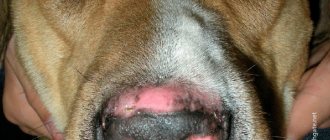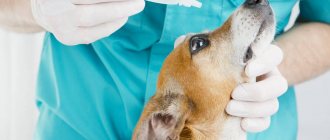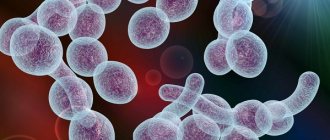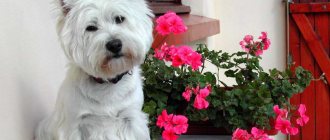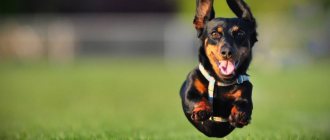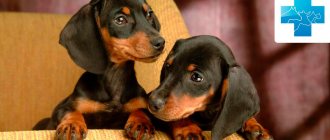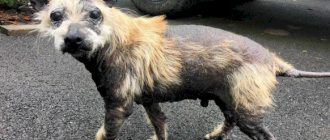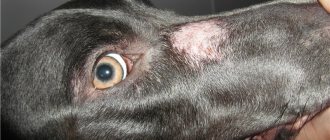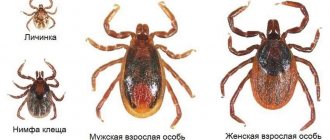A dog's skin is a dense and durable outer shell of the body, which sooner or later can be affected by fungus. Young pets with weak immune systems and pets that have been poorly cared for are at high risk of contracting fungal diseases. Dogs with poor heredity and special individual characteristics of the body are also vulnerable to fungal dermatitis.
Fungal diseases in dogs are accompanied by destruction of the skin, resulting in poor health of the animal. It is important to identify the fungus in a dog in a timely manner and not delay treatment. When the first signs of fungal dermatitis appear, you should immediately seek help from an experienced veterinarian.
What does fungus look like in dogs?
Unfortunately, fungal infections look nonspecific. With dermatophytosis, there may be areas of fur on the skin that look like they were cut with scissors, with peeling and sometimes redness.
Itching is usually not observed unless there is a secondary infection. Less common is kerion, a nodular skin lesion caused by mycosis.
Yeast-like fungi of the genus Malassezia can color the fur and claws a reddish-brown color. There may be a coating on the skin of the same or yellowish color. Redness is also often present.
A waxy brown discharge may be found in the external auditory canals. Cutaneous candidiasis is extremely rare and may be characterized by ulcerations.
Prevention
Treatment of such infections is simple, but lengthy and expensive. To prevent infection, it is better to prevent it.
Hygiene
The animal's bedding should always be clean and dry and changed regularly. After washing the paws or bathing the dog, dry it thoroughly; liquid should not accumulate between the toes. It is better to cut off the fur around the pads.
Vitamins
The dog’s immunity itself copes with all fungal infections if it works without failures. To maintain it, vitamin complexes are prescribed.
It is especially important to promote the health of puppies, older dogs or dogs after illness.
Nutrition
The dog's food should be varied and nutritious, it should include all the useful vitamins and microelements.
It is important to add vegetables to the diet of breast-fed animals. Dogs fed commercial food are given the most balanced diet possible.
Insulation
Contact between domestic and yard dogs is prohibited.
Stray animals are often carriers of infections against which the pet’s immunity may be powerless.
Fungus in dogs: Causes
Dermatophytosis, or simply lichen, occurs more often in young, old and immunocompromised dogs. You can become infected by interacting with carriers and sick animals. Also upon contact with fungal spores in the environment. According to some reports, they can last from 18 to 54 months.
Yeast-like fungi Malassezia are normally present on the skin of dogs, but in very small quantities. When microscopying a smear from the skin or the contents of the external auditory canals, only one spore may be detected in one field of view. If there are more of them, then we can talk about fungal overgrowth. This condition already requires intervention.
Fungi of the genus Candida can normally be found on mucous membranes.
Causes of fungal overgrowth:
Any diseases of the skin and ears can be associated with secondary infection. Fungal overgrowth does not occur by itself; it appears only when the function/integrity of the skin is impaired.
Main reasons:
- Atopic dermatitis.
- Food hypersensitivity/intolerance.
- Flea allergic dermatitis.
- Otitis of various etiologies.
- Interdigital dermatitis.
- Interdigital furunculosis.
- Autoimmune diseases.
- Parasitic diseases.
- Some endocrine diseases.
Watch the video: Fungus in dogs. Malassezia or Malassezia dermatitis
conclusions
Fungal diseases occur when the immune system is weakened under the influence of unfavorable environmental factors, improper care, inadequate feeding, as well as congenital predisposition.
Do not violate sanitary and hygienic rules for caring for infected animals so as not to become infected yourself. If patches of alopecia appear, use external remedies. If additional pathological symptoms occur, seek veterinary attention. Do not weaken your pet's immune system with human delicacies and table scraps.
Watch the video:
Fungus in dogs: Diagnosis
For any lesions of the skin and ears, it is better to first consult a veterinary dermatologist.
As a rule, the initial appointment takes at least an hour. This is necessary for collecting a complete medical history, examination with otoscopy and taking material for research.
Diagnosis of dermatophytosis:
- Wood's lamp glow.
- Trichoscopy - examination of wool under a microscope.
- PCR.
- Sowing on a nutrient medium.
- Histological examination of the putative kerion.
Yeast-like fungi:
- Cytological examination of a smear-imprint, skin scraping.
- Trichoscopy.
- Sowing on nutrient media.
Read other articles about dogs How to brush your pet: How to brush your dog’s teeth: How to care for your dog’s ears:
How to help your pet: Medicines
The key to successful treatment and the absence of relapses is eliminating the root cause.
Often, treatment for dermatophytosis may not be necessary, as spontaneous regression of the disease may occur. However, the therapy is still worth using, as the risk of spreading spores and infection, including to people, is reduced.
Treatment includes topical medications: Liverazole, Lime Sulfur, Shampoos with ketoconazole . It is also necessary to use systemic drugs, for example Terbinafine .
To destroy spores in the environment, use a 1% solution of bleach , smoke bombs based on enilconazole, for example Klinafarm .
To enlarge the picture, click on it
Recovery prognosis
If treatment is started in a timely manner, the prognosis for getting rid of mycosis is usually good, and treatment will not take more than 3-4 weeks. In advanced cases, therapy lasts for several months, especially if lichen spots appear again and again. Ear fungus often leads to relapses and complications in the form of otitis, so it is often necessary to continue treatment for six months (or even more).
Confirmation of the dog’s cure is its good health, the overgrowing of the formed spots with hair, a decrease in their redness and swelling, and the absence of a glow in the fur under the lamp. However, if you want to be completely sure of the health of your pet, it is worth taking a second scraping from the site of the lesion.
Fungus on dogs' paws: Treatment
Often, especially in the autumn-winter period, fungus occurs on the paws of dogs. Treatment includes local treatments. In case of extensive lesions or difficult local therapy, systemic treatment is prescribed. We must also not forget about eliminating the root cause that causes fungus on the dog’s paws.
Topically, you can use 2-4% chlorhexedine, for example, Chlorexiderm spray . You can wash your paws after a walk with Malacetic . Cheap and affordable means you can use a 2-3% solution of ordinary table vinegar .
It should be noted that to monitor treatment, cytology must be re-taken periodically, since the reddish-brown color of the coat and claws may persist. It will be eliminated only when the skin derivatives are completely renewed.
To enlarge the picture, click on it
Risk group
Fungal diseases, with the exception of dermatomycosis, are not very common in Russia, so the likelihood of infection is not high. But there is a breed predisposition.
Systemic aspergillosis is more common in German Shepherds, and sinonasal aspergillosis is more common in any dog with a medium or long muzzle.
West Highland White Terriers, German Shepherds, Basset Hounds, Shih Tzus, Dachshunds, Boxers and Poodles are genetically predisposed to mallasesial dermatitis.
Histoplasmosis mainly occurs in hunting dogs.
Fungus in a dog's ears: Treatment
When treating otitis media, it is also important to eliminate the root cause. The most common fungus in dogs' ears is Malassezia. For successful recovery, it is necessary to clean the external auditory canal.
So what you need to do:
- Lotion ( Epiotic, Otifri, GlobalVet, Rosinka) or regular saline solution NaCl 0.9% . The latter is best used if it is not known whether there is a perforation of the eardrum.
- The ears are gently massaged at the base.
- Let the dog shake its head as much as possible.
- Gently remove visible discharge with cotton pads. Important! You cannot clean your ears with cotton swabs, as this will only cause the exudate to clog deeper.
- You don’t need to rinse your ears every day, as this can only further injure the inflamed tissues. Usually in a day or two.
15 minutes after washing, medications are injected into the external auditory canal. Use only local products. Systemic antibiotics are the only treatment required for otitis media.
If the external auditory canal is so narrow due to inflammation that drops cannot be administered, then a short course of corticosteroid tablets is used, for example Prednisolone .
The choice of drops in the ears depends on the cause of otitis media, the condition of the eardrum, whether there is bacterial or fungal overgrowth, or parasites.
Surolan can be classified as a “for everything” drug . The drugs included in the composition relieve inflammation, have antimicrobial and antifungal activity, and also help against otodectosis.
Even for fungal otitis, complex remedies are used: Posatex, Isotik, Oritsin, Otidez .
In some cases, the dermatologist himself makes “talker” - homemade drops that have the composition necessary for a particular case.
In dogs with a large amount of hair in the ears, it is recommended to trim them after the inflammation is relieved.
Note that the course of treatment for fungal otitis is long, in most cases from three weeks. Every 4-7 days, the effectiveness of treatment is monitored - otoscopy and cytological examination of the contents of the external auditory canal.
To enlarge the picture, click on it
Recommendations for caring for animals
Be sure to show your pet to the veterinarian and, after consulting with a specialist, select a good antifungal shampoo (look at the instructions - the drug should have a pronounced effect against yeast). You should wash your paws with shampoo as needed. As a rule, this is not required every day.
We do not recommend using regular shampoos designed for washing human hair.
Not only do they not kill the yeast, but they also strip away the natural protective layer on your dog’s skin. This only leads to aggravation of the pathological process. But! If there is no other choice, you can use products based on natural tea tree oil. This product has a pronounced antifungal effect and also improves the condition of the skin of sick animals.
Note that shampoos with an antifungal effect can be combined with the homemade remedy described above. But remember that all these products should never, under any circumstances, get into the dog’s eyes and ears! If you have doubts about the activity and friendliness of your pet, which may squirm violently and try to escape, plug its ears with cotton swabs.
By the way, let us remind you once again that there is no need to “rinse” a sick dog in a full bath. This is difficult (and with such volumes of drugs it will take a lot of money). It’s easier to do this: take three liters of water or disinfectant solution, and then carefully pour it over the dog. After this, you need to thoroughly wipe the armpits, paws, area around the tail and groin with the medicine. If this procedure is performed well enough, very soon the manifestations of the infection will subside: the dog will itch much less and the nasty smell will disappear.
Proper nutrition plays an important role. It is necessary to exclude all carbohydrate foods from the dog’s diet as much as possible. This includes a variety of cereals, bread, potatoes, etc. We also recommend eliminating all dry food from the diet. This is due to the fact that the growth of yeast slows down significantly (or even stops altogether) if it is deprived of a source of carbohydrates.
